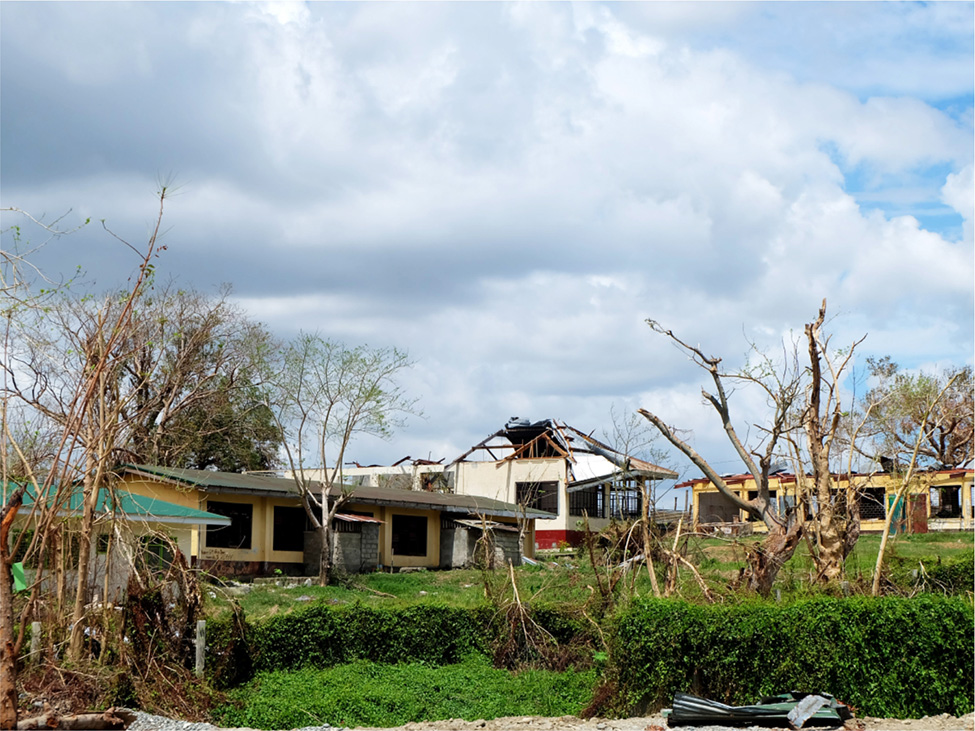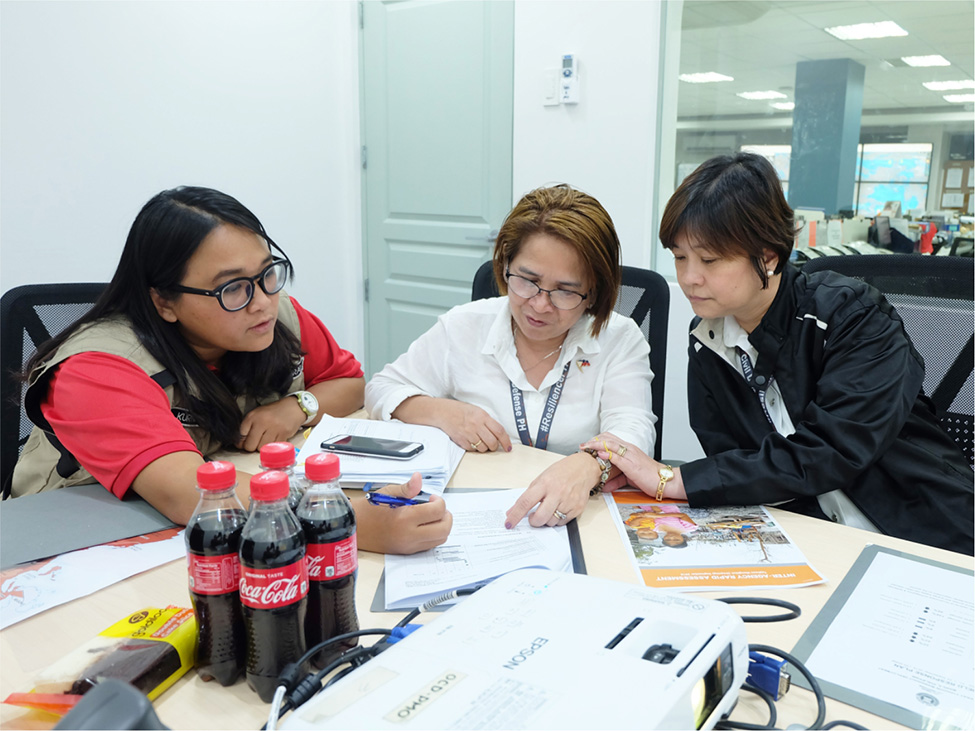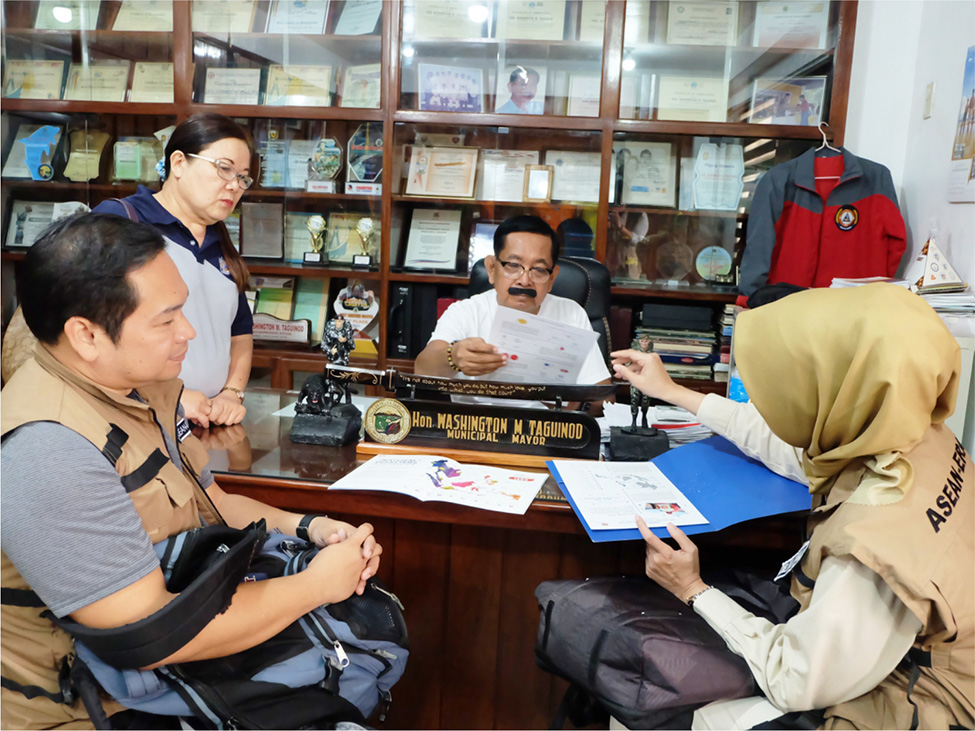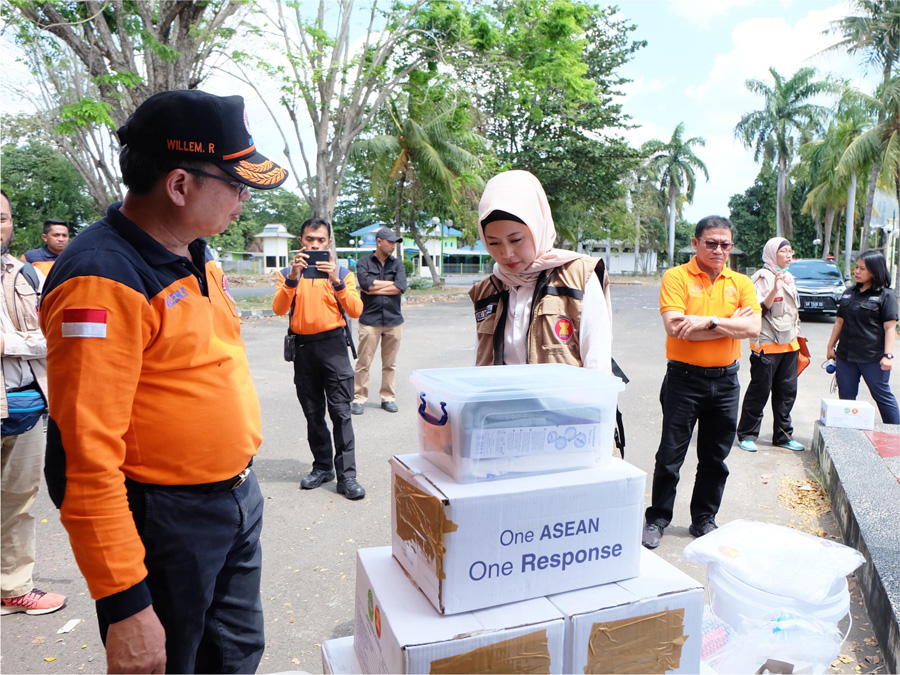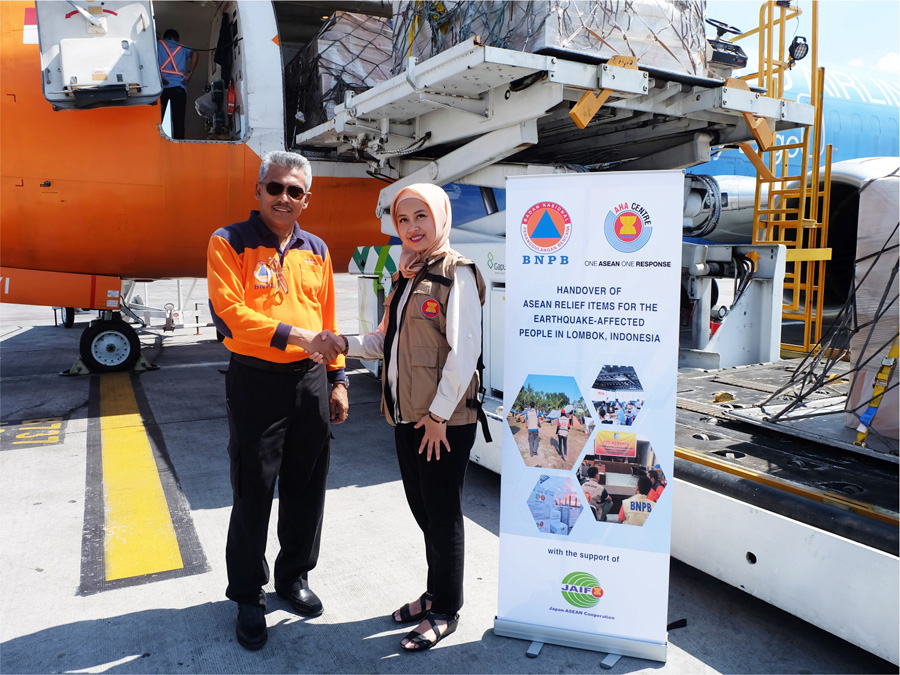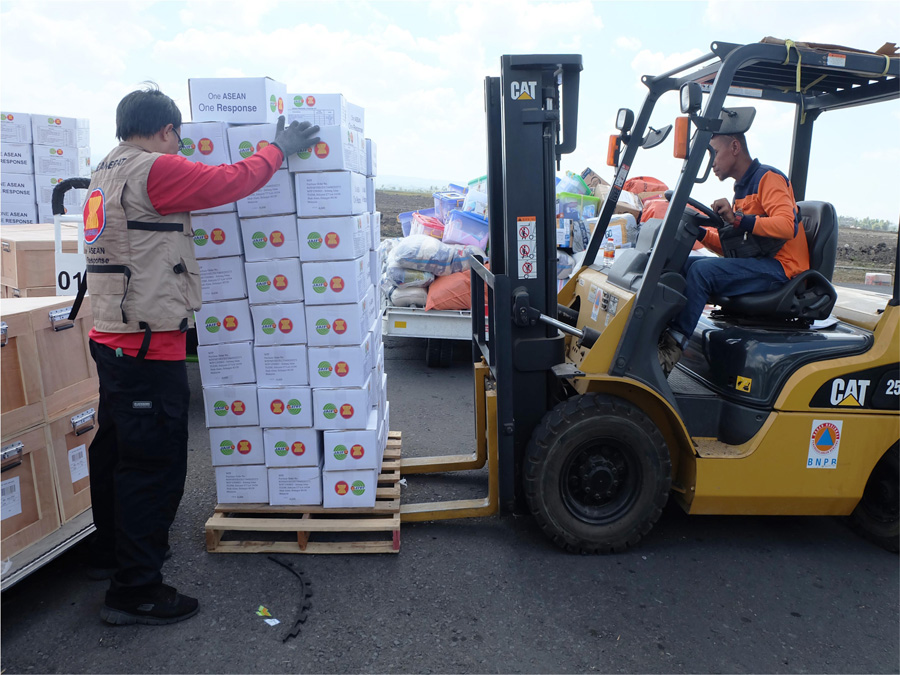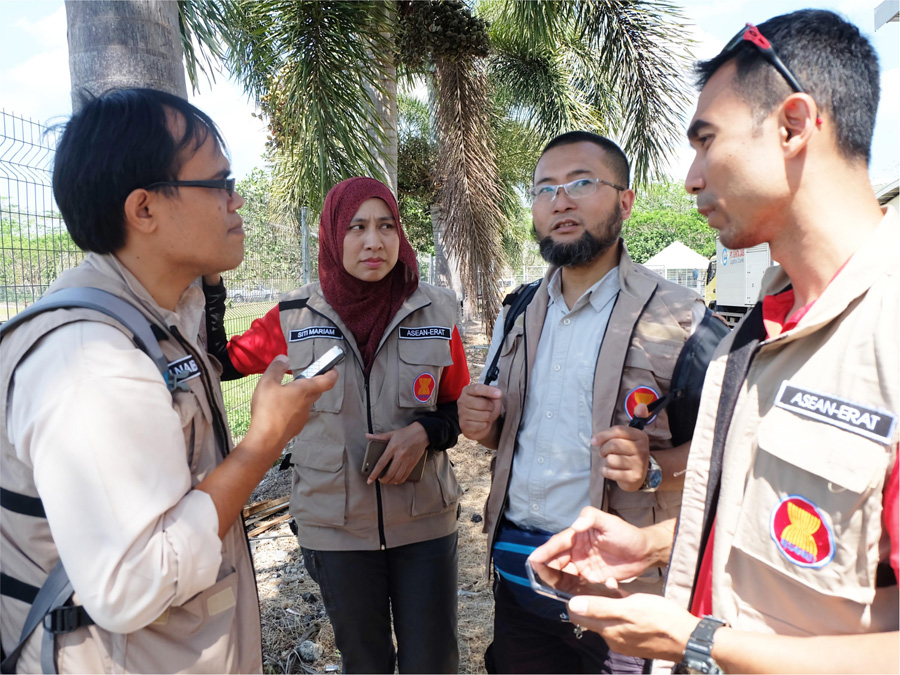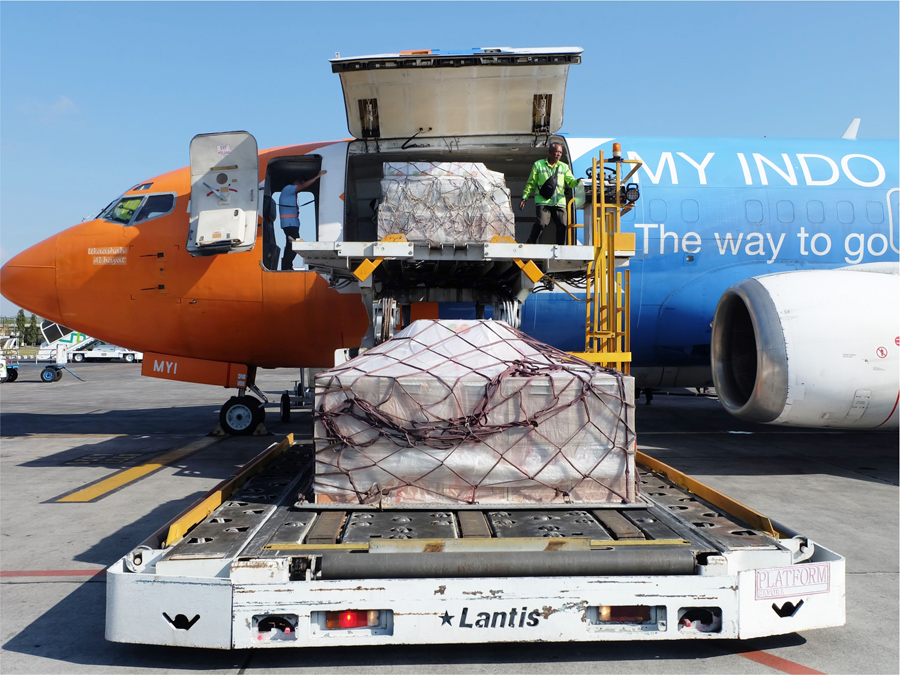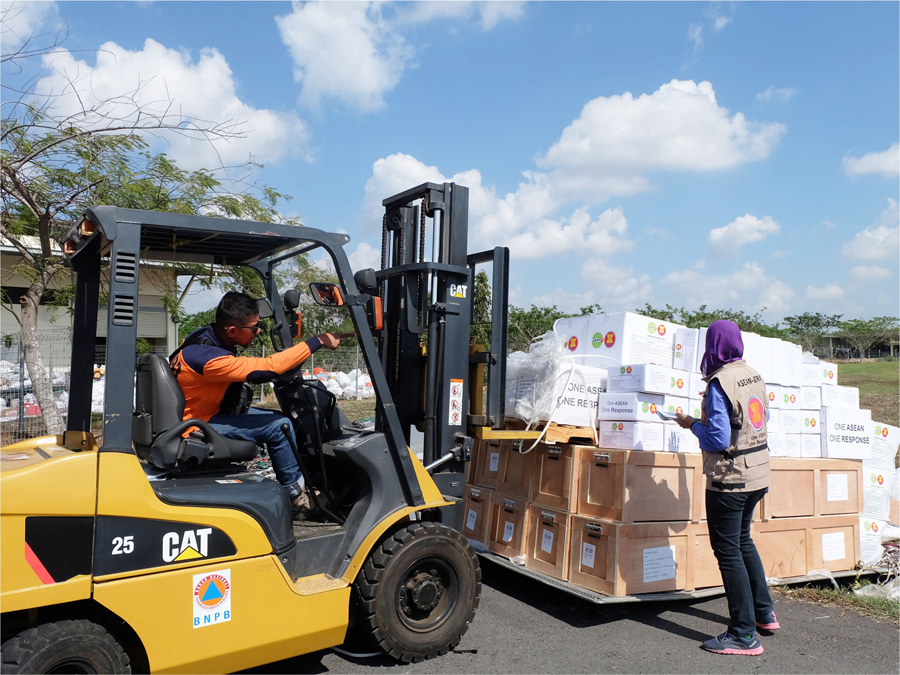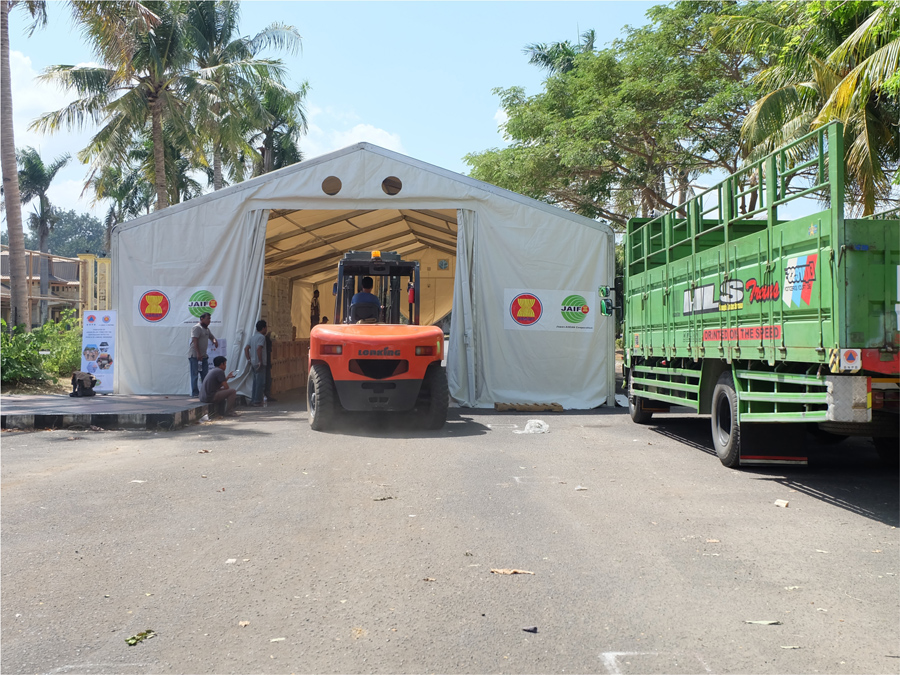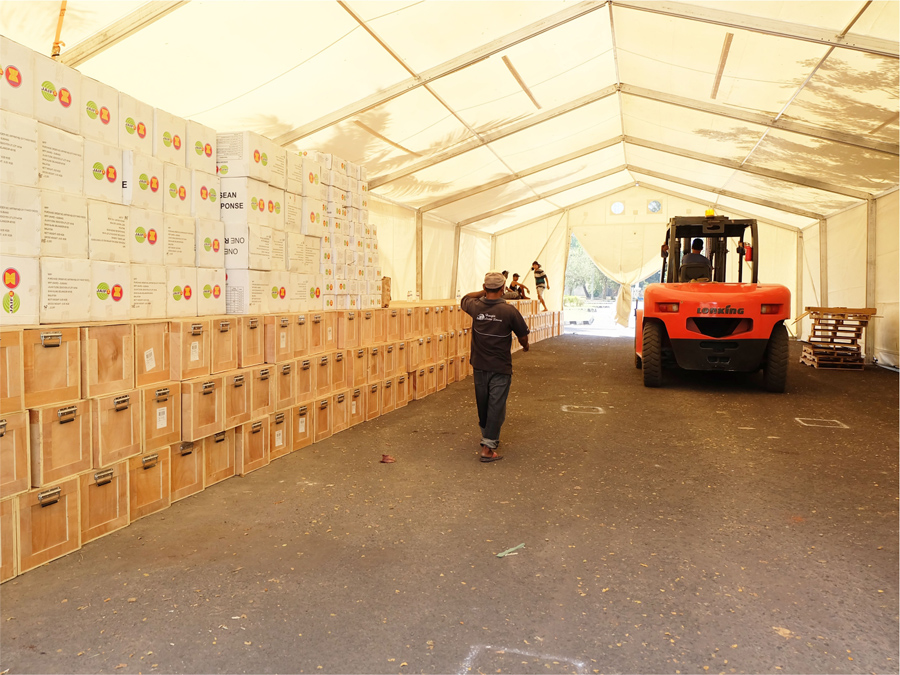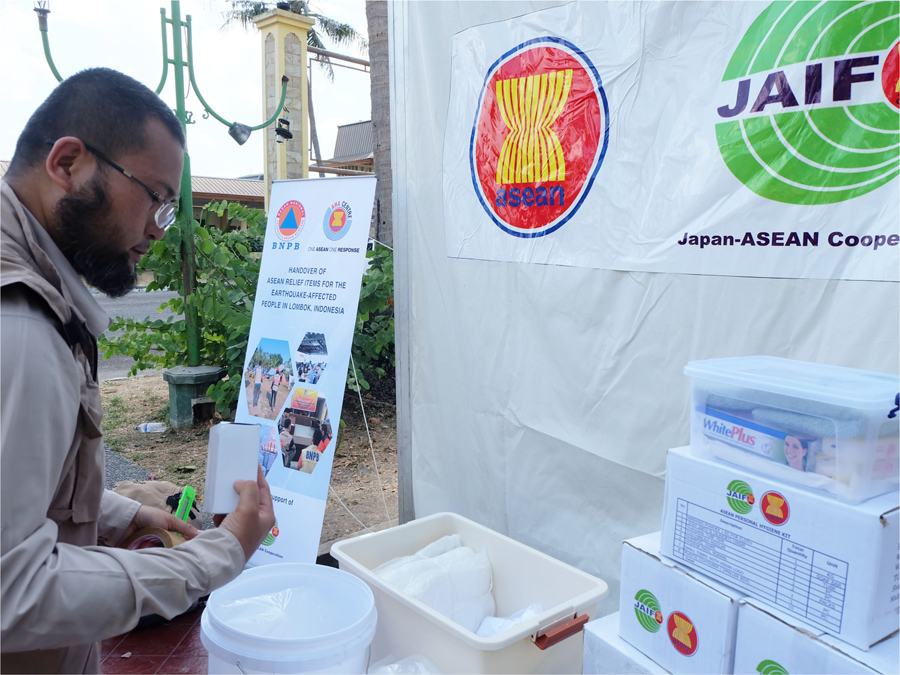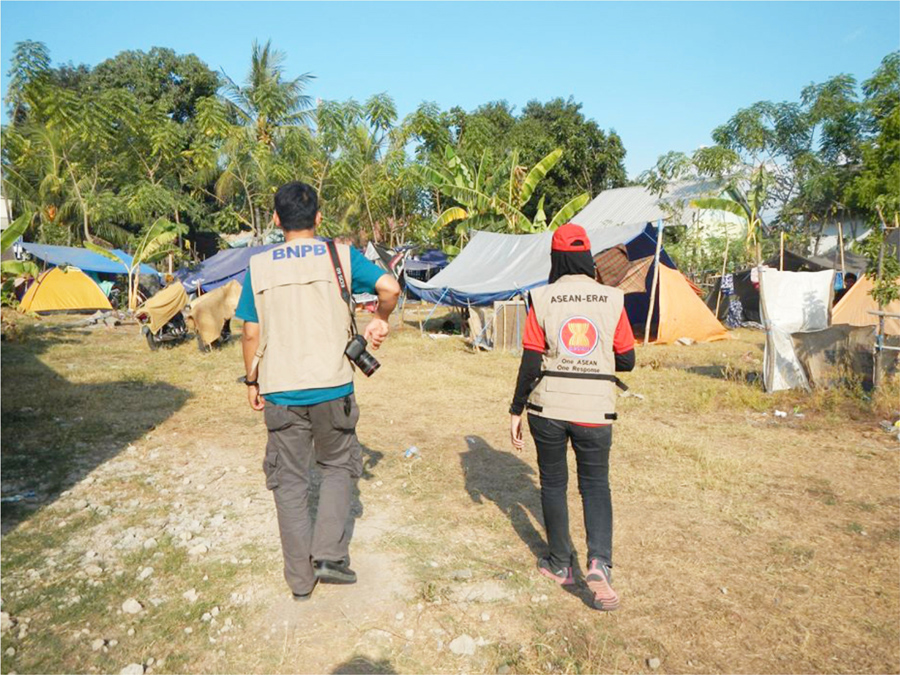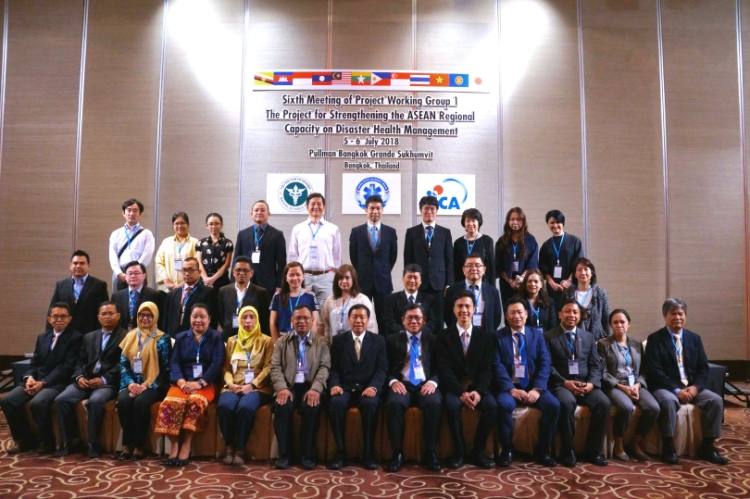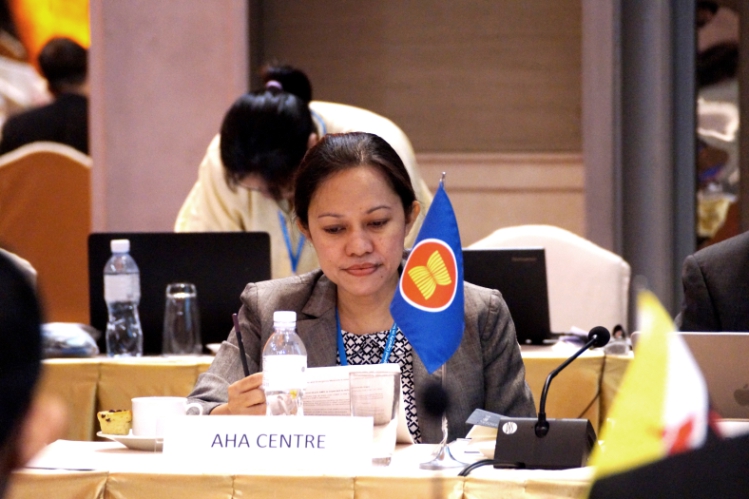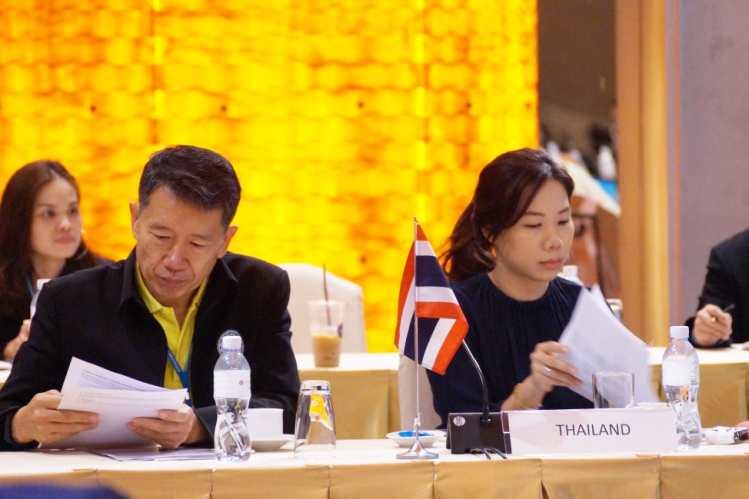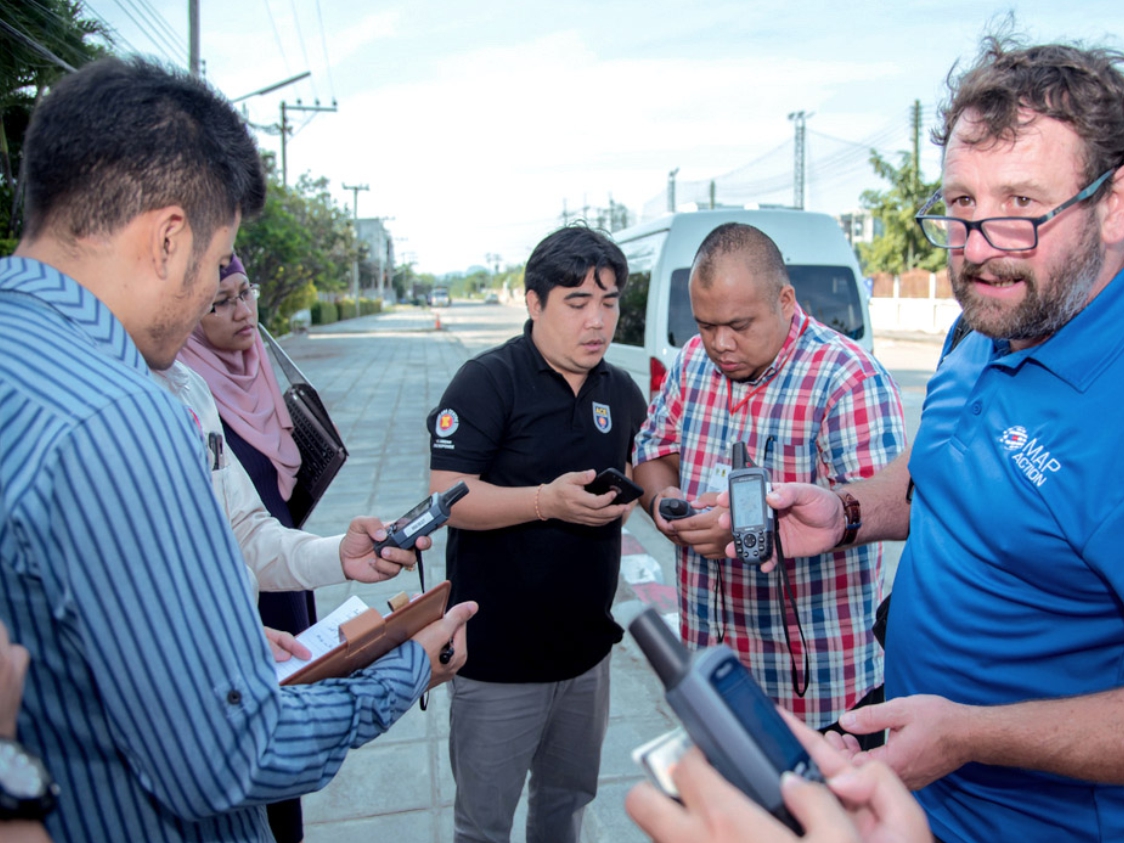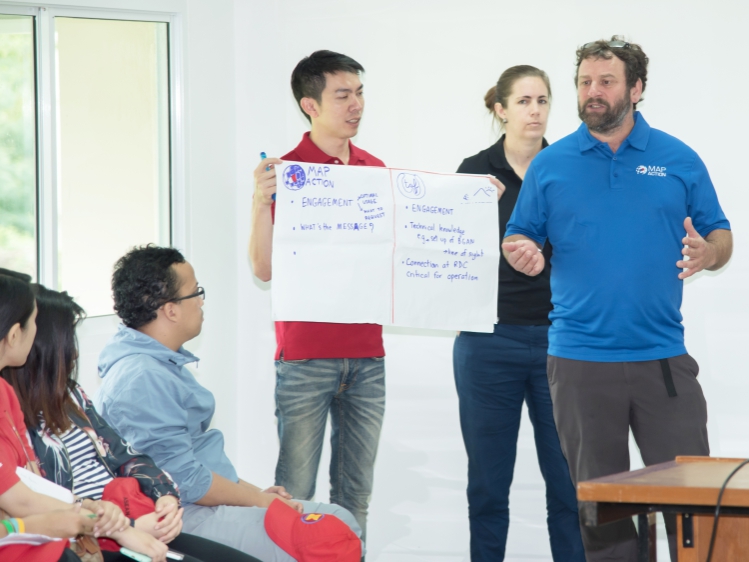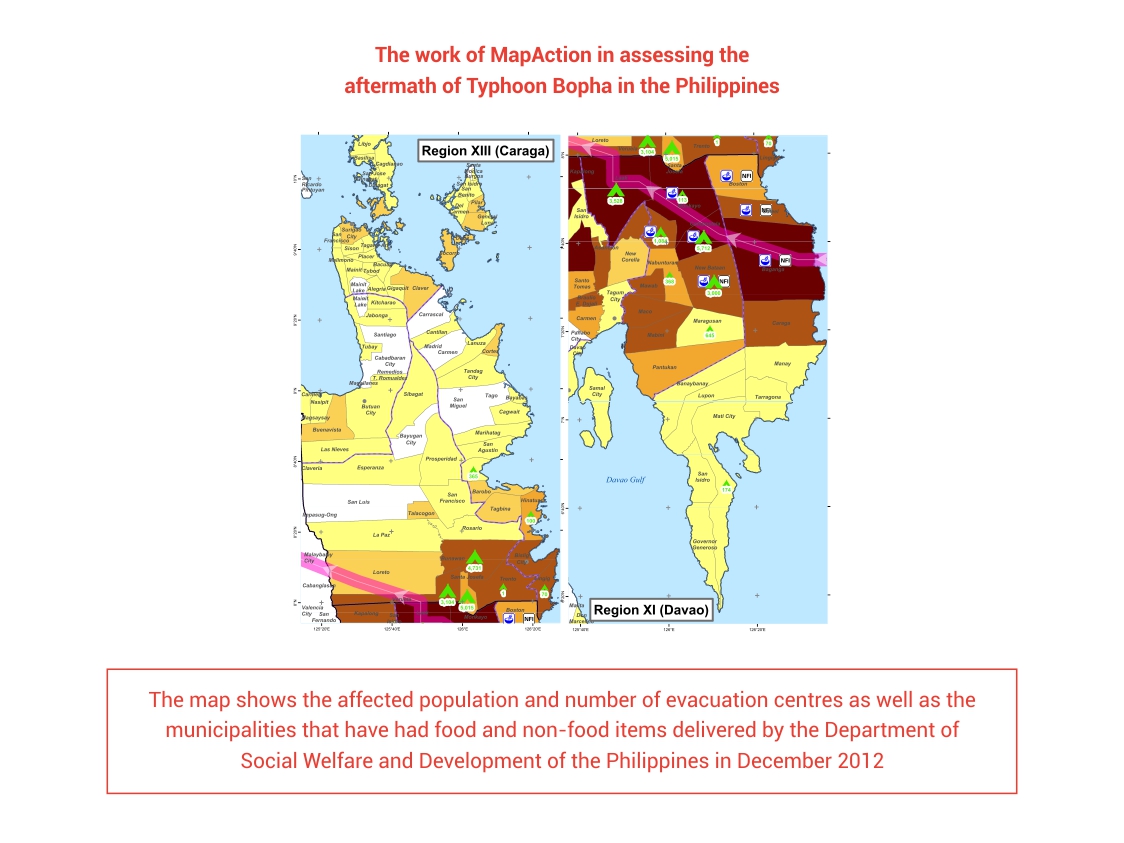Vol 43-ONE ASEAN ONE RESPONSE for Typhoon Mangkhut

ONE ASEAN ONE RESPONSE
FOR TYPHOON MANGKHUT
By mid-September it was all-hands-on-deck in the AHA Centre, with the monitoring team tracking the formation of largest storm cell of the year so far, as it made its way across the Pacific Ocean with a population of millions across the Philippines directly in its path. Communities along the nation’s northern coastline and outer islands were being evacuated, as preparation was well underway for the onset of Super Typhoon Mangkhut (Ompong). On the 15th of September, Typhoon Mangkhut made landfall in Cagayan Province, continuing its path westward with extreme winds and lashing rain, and leaving in its trail over 2.5 million people affected across the Philippines.
Afterwards, a total of 8 provinces and seven cities/municipalities have been announced under state of emergencies, with widespread damage to homes, infrastructure and livelihoods. Typhoon Mangkhut – that had an actual diameter larger than 2013’s Typhoon Haiyan – claimed over 50 lives, with hundreds more injured, and over 180,000 homes either fully or partially damaged. Total damage has been estimated at over USD 6 million, with communities particularly affected by secondary hazards that accompanied the typhoon, such as flooding and landslides. However, was it not for the coordinated effort in the days prior to the storm by the various national and sub-national agencies, alongside communities themselves, loss of life and damage could have been far worse.
“We pre-positioned the Cagayan Valley Response Team in advance, with early evacuation taking place two days prior to the typhoon’s landfall. We also estimated the numbers of people likely to be affected, and provided hygiene kits, non-food items, and generators. These preparedness measures managed to minimise casualties in our region”, explained Mr. Dante Balao, the Regional Director of Office of Civil Defense (OCD) Regional Office II, in Tuguegarao, Cagayan.
Alongside tracking the progress of Typhoon Mangkhut in the weeks and days leading-up to the disaster, the AHA Centre was also engaged with the Philippines Government, through the Philippines’ National Disaster Risk Reduction and Management Council (NDRRMC), in both the preparation and response to the storm. At a later stage, the ASEAN Emergency Response and Assessment Team (ERAT) was mobilised to provide information management and assessment report as the emergency phase coming to an end. On the 15th of September, just hours after the typhoon made landfall, the AHA Centre In-Country Liaison Team arrived in the Philippines, to establish direct communication with the NDRRMC in Manila and in affected areas, and to facilitate ASEAN’s assistance to those in need.
In response to the disaster, the AHA Centre mobilised relief items valued at over USD 275,000 to communities across the affected regions, including 30 tonnes of rice, four generator sets, and 2,000 rolls of tarpaulins. During the handover ceremony on September 24th, Undersecretary Ricardo B. Jalad, the Executive Director of NDRRMC and the Administrator of the Philippines’ Office of Civil Defense showed his appreciation for ASEAN’s support when he stated “I would like to thank and express my deep gratitude to the AHA Centre for facilitating this assistance”.
While Typhoon Mangkhut was a disastrous event for the Philippines and the ASEAN region, it presented an opportunity for the AHA Centre and ASEAN-ERAT to engage on a new element as part of the region’s ongoing efforts to improve disaster management practices. Three ASEAN-ERAT information management specialists were deployed to support the NDRRMC office with data analysis, data visualisation and report writing. One of the ASEAN-ERAT Level 2 members deployed to the Philippines, Adiratna Wira from Malaysia, recognised the importance of information management support for response agencies during disasters. “Aside from the actual products developed, there was great benefit for both the NDRRMC and ASEAN-ERAT members”, said Adiratna. “There was increased understanding in the roles and ways of working for each party, which could speed-up a range of processes and information distribution in the future.”
On the last day of the ASEAN-ERAT’s deployment, Mr. Edgar Posadas, the Director of Operations Service and Spokesperson of the NDRRMC emphasised, “we know that our region is always at risk of disasters, but with neighbours like you and friends like you, we know that things will be moving forward. We are thankful to our ASEAN neighbours and the AHA Centre for your help. The ASEAN region is advancing, we don’t have to go beyond our borders (to respond to disasters), so those beyond the ASEAN corridors can attend to their own disasters. I think it’s a way to go now, everybody is trying to be self-sufficient. We have to be ready should simultaneous disasters are taking place. So, the more capacity that we have and the more prepared we are, the better it will be for the people”.
Written by: Shintya Kurniawan | Photo : AHA Centre
- Published in Highlight
Vol 42-ONE ASEAN ONE RESPONSE for Lombok

ONE ASEAN ONE RESPONSE
FOR LOMBOK
During August 2018 the AHA Centre once again evidenced ASEAN’s solidarity for disaster-affected population in the Southeast Asian region, this time supporting communities in the well-known tourist destination of Lombok, West Nusa Tenggara, Indonesia. The area was recently the epicentre of multiple earthquakes, with the initial major quake recorded at M 6.4 on Sunday the 29th of July. A week later, on the 5th of August, a larger M 7 earthquake hit the already-affected area, increasing numbers of casualties and causing greater damaged to buildings and livelihoods within the Lombok region. The main shock also triggered a tsunami warning, which thankfully did not result in an actual tsunami event. However, throughout the month of August, over 1000 aftershocks were recorded by the Meteorological, Climatology, and Geological Agency of Indonesia (BMKG), with the region still remaining vulnerable to quakes during the ongoing recovery phase.
Following the main earthquake on the 5th of August 2018, the AHA Centre intensified its cooperation with Indonesian National Disaster Management Authority (BNPB), which had been ongoing since the initial quake in late July. Upon receiving notification of the second earthquake, the AHA Centre immediately deployed a staff member to the field, provided information management and translation support for BNPB, as well as facilitated the deployment of an ASEAN Emergency Response and Assessment Team (ERAT) to the affected region. A little later, the AHA Centre obtained a green-light to mobilise relief items from the ASEAN emergency stockpile in Subang, Malaysia. These relief items – worth approximately USD $154,438 – were picked-up by the BNPB using a chartered flight, arriving in Praya Airport, Lombok, in three batches between early to mid-August.
For Lombok, earthquake events are not particularly new, with notable earthquakes recorded in the region from as early as the year 1856. Consolidated data from the United States Geological Survey and the Indonesian Meteorological and Climatology Agency (BMKG) also noted that major earthquakes above M 6 occurred on the island in 1970, 1972, 1978, 1979, and 2000. Based on the latest National Disaster Risk Index – published by BNPB in 2016 – Lombok is categorised as a medium to high-scale earthquake-prone area. Considering these vulnerabilities and risks, the resettlement areas currently underconstruction will use similar earthquake-resistant technology that has been adopted through the post-earthquake recovery periods in Aceh and Nias, Sumatera, Indonesia.
“Indonesia is part of the ASEAN community, and the BNPB has been working closely with the ASEAN coordinating agency for disaster management, or AHA Centre. All Heads of State and Government of ASEAN countries have agreed to stand as one, whenever natural disasters happen in neighbouring states. Based on the One ASEAN One Response Declaration, Indonesia trusts the AHA Centre to provide additional logistical support that is required for the emergency response. For example, this Mobile Storage Unit we stand in that can serve as a portable warehouse, and family tents that can provide shelters for the displaced communities”, said H.E Willem Rampangilei, the Chief of BNPB, in between the emergency responses in Lombok.
On a similar note, the Executive Director of the AHA Centre, Ms. Adelina Kamal, stated that “the ASEAN relief items belong to all ASEAN countries, including Indonesia. When a disaster occurs and relief items are required, ASEAN Member State can access the regional stockpile, and the AHA Centre will facilitate its mobilisation to the affected areas. We would like to show our appreciation to the BNPB for the confidence given to the AHA Centre in complementing the government’s life-saving efforts on the ground. Our partnership strengthens the vision embodied in the ASEAN Declaration on One ASEAN One Response”.
All ten ASEAN Member States have recognised the AHA Centre as the primary regional disaster management coordinating agency in ASEAN. Indonesia has been actively involved in the establishment of the AHA Centre, and has been hosting the AHA Centre since it first opened in November 2011. The mission to Lombok is the AHA Centre’s fifth response this year, bringing the total responses to 23 emergencies in 7 ASEAN countries since the AHA Centre’s establishment.
Written by: Shintya Kurniawan | Photo : AHA Centre
- Published in Highlight
Vol 40-Third ASEAN Member States Training on Disaster Health Management, Arch Project

THIRD ASEAN MEMBER STATES TRAINING ON
DISASTER HEALTH MANAGEMENT, ARCH PROJECT
BANGKOK, THAILAND, 28-31 MAY 2018
Health and medical support forms one of the primary, most important elements for assisting communities facing disaster. The ASEAN Regional Capacity on Disaster Health Management (ARCH) project, being implemented from 2016 to 2019, forms a cornerstone of the region’s efforts to engage health services with maximal impact in the disaster management field. As part of this project, the AHA Centre engaged in the Third ASEAN Member States (AMS) Training on Disaster Health Management, which took place in Bangkok from the 28th to the 31st of May 2018.
The key focus of this strategic training was to learn about, and develop integrated processes for working with International-Emergency Management Teams (I-EMT), who form a primary source of experience and skill in medical responses to disaster situations. This focus included learning about the processes and effort required in receiving and deploying I-EMTs, understanding I-EMT core requirements before, during and after deployment, as well as understanding the role of the recipient country within coordinating I-EMT deployments.
To set about achieving the workshop’s aims, the AMS training delved into information regarding EMT minimum standards, including the ARCH project’s role in helping achieve such standards, as well as how achieving such standards could be undertaken within the ASEAN context. Much discussion was also afforded to identifying challenges to achieving standards – such as customs compliance, waste management, safety and security, and insurance – and highlighting opportunities to overcome such challenges that would result in more efficient and fluent engagement of I-EMT support at times of disaster.
The training highlighted that these key challenges formed the primary obstacle for better engagement of I-EMT within ASEAN disaster response efforts, and that such obstacles could be overcome at a regional level – with the support of the ARCH project. The ARCH project itself aims to develop Standard Operating Procedures for deployment of EMTs within the region, alongside an EMT database, both of which would serve to support the standardisation and management of I-EMTs operating within the ASEAN context. The training also identified the development of pre-agreements between ASEAN Member States regarding such elements as importing dangerous goods and controlled substances, which would be advantageous within the engagement of I-EMTs during disaster response.
Written by : William Shea | Photo : AHA Centre
- Published in AHA Centre Diary 1
Vol 40-MAP Action

MAPACTION
Mapping is perhaps one of the first things that springs to mind when we think of disaster preparedness and response. It forms an integral element of determining affected areas, infrastructure and terrain, as well as access for supplies both in preparedness planning and when disaster strikes. MapAction has been supporting the emergency management sector with professional mapping services, sending teams to respond to around 80 disasters across the world, and impacting the lives of tens of millions since its establishment in 2002. Based on such experience, and the importance of mapping within the disaster management context, the AHA Centre and MapAction recently formalised their working partnership through the signing of a Memorandum of Intent (MoI) during the 8th Meeting of the Governing Board of the AHA Centre held in Kuala Lumpur, Malaysia, on 27 June 2018.
Although the ink is still drying on the formal partnership between the AHA Centre and MapAction, the two institutions have already forged a strong working relationship throughout recent years, primarily engaging through the AHA Centre-led ASEAN Emergency Response and Assessment Team (ASEAN-ERAT) training programme. MapAction has provided valuable support to participants in the ASEAN-ERAT workshops, with hands-on training using state-of-the-art mapping applications that support the work of ASEAN-ERAT during disaster response. Training on the use of these applications has allowed ASEAN-ERAT members to engage in data visualisation and communication of the impacts of disasters during deployments on the frontline, and such working efforts paved the way for the development of the AHA Centre and MapAction’s formal partnership.
This recently signed MoI will ensure that a range of activities will be undertaken with a focus to mutually-beneficial outcomes for both the AHA Centre and MapAction. Under the MoI, MapAction will engage their skills and experience to support the development and implementation of emergency management in the region by providing GIS-based mapping support for ASEAN-ERAT deployments to regional and international emergency response operations, as well as providing GIS-based remote mapping material support for the AHA Centre upon request. Accordingly, the AHA Centre will support MapAction’s work by facilitating access to disaster-affected areas, including obtaining visas and customs clearance for MapAction’s equipment, and also identifying and facilitating potential collaboration opportunities between ASEAN Member States and MapAction to enhance information management and the use of GIS in emergency preparedness and response efforts.
The two parties will also embark on a range of shared projects, with the aim to strengthen the long-term sustainability and development of disaster management capacity in the ASEAN region. Such efforts will include a jointly-developed training curriculum for an ASEAN-ERAT specialised course on GIS mapping and technology, alongside practising joint deployment within the ASEAN Regional Disaster Emergency Response Simulation Exercise (ARDEX) and ASEAN Regional Forum Disaster Relief Exercise (ARF DiREx) implementations. Such mutually-beneficial partnerships form a key element of the AHA Centre’s partnership strategy, as summed up by the AHA Centre’s Executive Director Ms. Adelina Kamal,
“The knowledge and practical skills shared by MapAction through joint training and exercises will allow the AHA Centre and our ASEAN-ERAT members to better assist the disaster-affected country and enhance coordination with other humanitarian actors in line with the spirit of One ASEAN One Response.”
Written by : William Shea | Photo : AHA Centre, MapAction
- Published in Partnership

